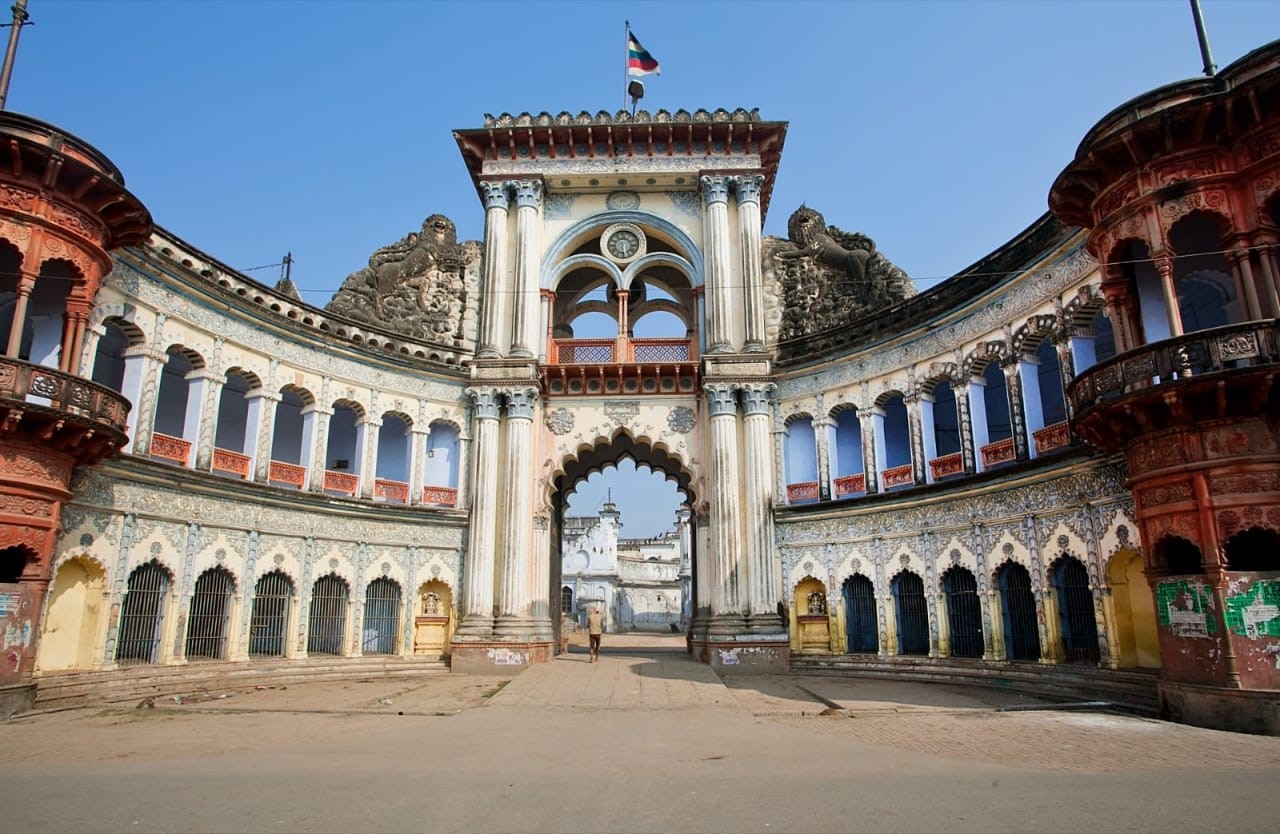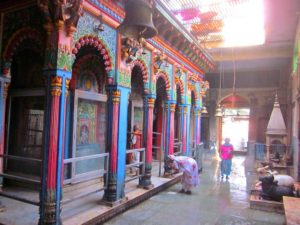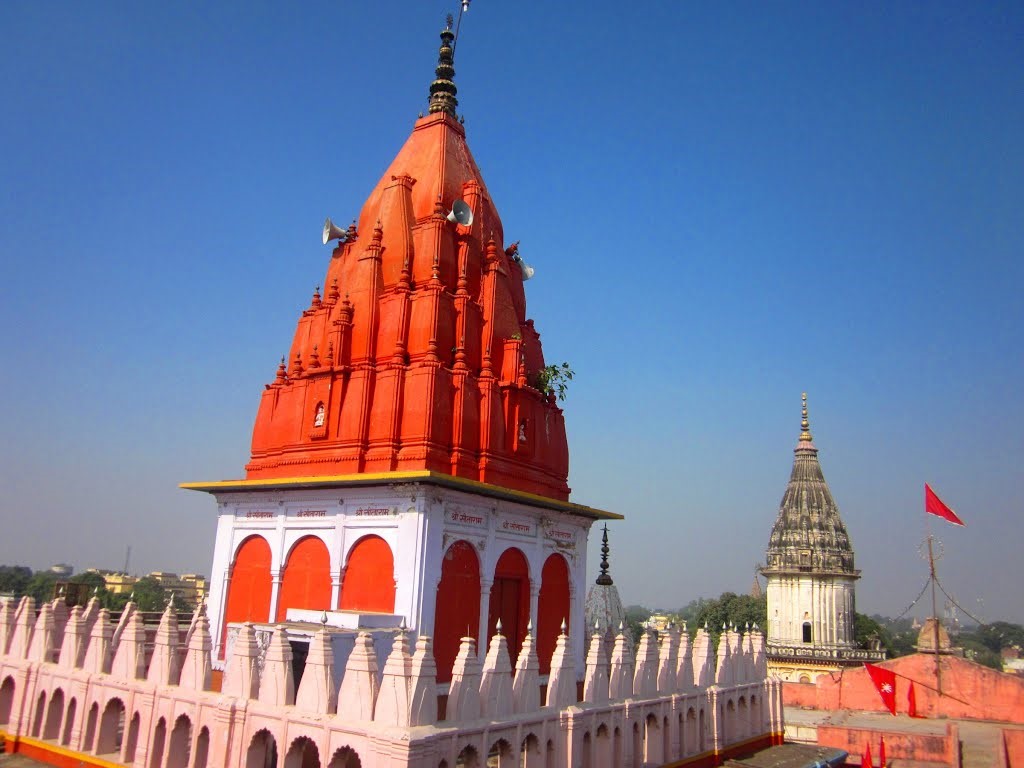By Smita Mukerji

The movement for reclaiming the Rāma Janmabhūmī site over the past three centuries can be regarded as the standard bearing struggle in the Hindus’ bid at civilisational reassertion by regaining control of their sacred sites in their homeland, which had been destroyed by invading barbarians and inimical ideologies during the past millennium. But the soundness of their claim is sought to be challenged today not only on the question of possible archaeological remains of a preexisting, pre-Islamic structure, but also impugnment by lobbies opposing it of the sacrosanct status of Ayōdhyā in Hindu canon, its antiquity and association with the worship of Śri Rāma, disregarding the substantial corroborative material from which these are borne out.
The discourse has also been plagued by a surfeit of spurious evidences, impassioned but ignorant claims, communal animus and political propaganda, which have turned it into a seemingly irresoluble maze. In order to therefore see through the innumerable convolutions in this most emotive issue in the Indian political space, it is imperative to get a clear perspective on all the elements of this dispute, most importantly the history of Ayōdhyā itself, which was for the most part placid, but interrupted by spurts of tumult.
Ayōdhyā has a continuous history of over two millennia corroborated through various sources, the earliest reference to which can be found in the Aṭharva Vēda.[1] We pick up the story at a somewhat later point in this epoch, at the fag-end of the mediaeval era.
Under Peshwa Bajirao I (years active: 1720-1740) Marāṭhā power had expanded rapidly to the north of India and remained ascendant for almost a century until it was outstripped in contention with the British. About four decades earlier, the founder of the Marāṭhā empire, Ćhatrapati Shivaji, had on his deathbed laid down the mission of the Marāṭhā empire, to wrest control of and restore prominent venerated shrines of Hindus[2] which had been destroyed in the inferno of fanaticism of the Mughal Emperor Aurangzeb and previous Islamic rulers. Persevering on this purpose, in 1751, during the reign of Ćhatrapati Rajaram II, Malhar Rao Holkar requested the second Nawab of Awadh, Mansur Ali (Safdar Jung) to hand over Ayōdhyā, Kāśi and Prayāga to the Marāṭhās, in return for succour provided in his conflict with the Rohilla pathans.[3], [4] This demand was renewed in 1756[5] when the third nawab, Shuja-ud-Daulah, once again approached the Marāṭhās for help against an impending attack by the Afghans.

After almost a year of negotiations, in 1757, the nawab finally agreed to cede Ayōdhyā and Kāśi to the Marāṭhā chief Raghoba. However, owing to the latter’s preoccupation in the Punjab and on account of the nawab’s reluctance, since Ayōdhyā was the capital of Awadh state, this could be implemented only in 1759[6] when Peshwa Balaji Bajirao[7] expressly directed the Marāṭhā general in North India, Dattaji Scindia, to take over the two cities.[8] This was a significant event in the history of Ayōdhyā since this led to the migration of a substantial Muslim population and almost the entire Muslim nobility from Ayōdhyā to Faizābād, the new capital of the Awadh state.
Ayōdhyā in the rule of the Awadh Nawabs


The founder of the Awadh nawabi, Burhan-ul-Mulk Sa’adat Khan (r. 1722 – 1739), was a Khorasani Persian who belonged to the celebrated Saiyyad family of Najaf. He made his career serving first the Saiyyid Brothers, then deserting them in favour of the Mughal emperor, Farrukhsiyar, and thereafter betrayed him too and defected to the invading Nadir Shah in 1739. He was appointed to governorship of Awadh on September 9, 1722. He waged war with scores of local Hindu and Muslim chieftains[9] who had declared themselves independent with the weakening hold of Mughal state, and subdued them to unify the province of Awadh and established his capital at the banks of the Sarayū, about two kilometres from Ayōdhyā. His treacherous ways notwithstanding, he was liberal in his treatment of his Hindu subjects. To enlist their support he appointed numerous Hindus to important posts in the army and administration, including the revenue department, and with their help devised ways to increase revenues and succeeded in building a prosperous state without rack-renting the peasantry.
The reigns of Sa’adat Khan and his successor, Safdar Jung (r. 1739 – 1754) witnessed the establishment of numerous sects of Vaishñava bairāgīs[10] and the renovation and reconstruction of several temples in Ayōdhyā. Govinda Das established the Nirmōhī akhāḍā[11] at Rāmtīrtha (Rāmghāṭ). Safdar Jung’s prime minister and army commander, Nawal Rai, built a substitute Janmasthāna temple on a piece of land granted by a noble, Mir Masum Ali Mafidar (to one Ramadas, pupil of Devamurari of the Gudar sect of Prayāga, in 1730[12]) and renovated the Nagēśwaranath and Lakṣmañ Qilā temples at Ayōdhyā.
The Ayōdhyā Sanads

Around this time, the Rāmānaṇdī bairāgīs also moved in, and under the leadership of Swami Balananda Das, took possession of many areas of Ayōdhyā. In a sanad[13] of July 8, 1723 that confirmed a previous deed made by the Mughal emperor Aḳbar (dated March 28, 1600, on the day after Rāma Navamī), 6 bighas of revenue-free land in the province of Awadh[14] was granted by the order of Abul Fatah Nasir-ud-Din Muhammad Shah to the Rāmānaṇdī bairāgī sādhū Abhayarama Das in perpetuity, for the construction of a temple on a mound known as Hanumāntīlā, the site of the ancient Hanumāngaḍhī. Another sanad[15] dated December 22, 1722 issued earlier, containing an order of exemption from taxes on the granted land (madad-i ma’ash) directed the grantee to build a residential complex for the sādhūs on the land.
The third nawab, Shuja-ud-Daulah (r. 1754-75) though known to be a man of personal moral laxity,[16] was exceptionally generous towards his Hindu subjects,[17] demonstrated faith in local traditions[18] and valued his relationship with Hindus.[19] His military alliances however followed a more ambiguous pattern.
During the 1761 Pānipat War, Shuja-ud-Daulah abandoned his ties with the Marāṭhās and along with the Mughals, sided with the invading Ahmad Shah Abdali. Being a Shia he had no love lost for the Afghans, but feared the prospect of the Marāṭhās gaining more ground in the North. Though Abdali secured an advantage in this encounter, the nawab’s army was badly mauled by the Marāṭhās and incapacitated so severely that in the following years he was unable to withstand the modest army of a trading company—which was the status of the British until that time—at the Battle of Buxar (1764). At this point it was a strong contingent of the Daśanāmī sanyāsīs under Umrao Giri and a large number of bairāgī sādhūs who shored up the nawab’s army.[20] The Gosāīṅ contingent was apparently so outstanding in their fighting prowess that they were estimated to be, in the words of Colonel Champion, the conqueror of Rohilkhand, as “the best cavalry in the Oudh.”
These amicable conditions continued in the era of the fourth nawab, Asaf-ud-Daulah – Muhammad Yahya Mirza Amani (r. 1775-1797). By the time of his nawabi Mughal rule was sufficiently diminished,[21] allowing the nawab to assert regnency independent of allegiance to the Mughal crown. Asaf-ud-Daulah never appeared at the Mughal court to pay homage.[22] His descendent, Abul-Muzaffar Ghazi-ud-din Haider Khan (r. 1814-1827) completely did away with allegiance to the titular Mughal overlord by assuming the title of padshāh, getting a coin struck and the khutbā read on his own name, and sent four crore rupees and gifts to the Khalifa.[23]
Asaf-ud-Daulah granted one acre land in Ayōdhyā to Dayaram of Ćiṭrakūṭa on which Khāki akhāḍā was established, and another piece of (0-1-0) land was granted to Kishan Dutt Pande for the establishment of Nārāyaña at Lakśmana Ghāṭ. The hermitage of Ramprasad was built on (2-3-0) land granted by a landlord, Azhar Husain Mafidar, and Ram Charan Das received grants of 2 acres of land for his Ṭhākura Dwāra and a further 4 acres for his akhāḍā from one Mir Omadali ‘Jemindar’. A number of Rāma-Jānaki temples were built by the sādhūs of the Rāmānaṇda sect. Purushottama Das of Kōtabūndī laid the foundation of the Mahānirvāñī akhāḍā, and the Nirālambi sect was founded by Viramala Das of Kōtā. Several Hindu and Jain temples, tanks and mûṭhs were also built in the Aliganj-Lucknow area, where the nawab shifted his capital subsequently from Faizābād.[24]

The British East India Company had however by this time gained significantly in power and influence, imposing harsh treaties following the Battle of Buxar that placed a heavy financial burden on Awadh. Asaf-ud-Daulah’s successor, Wazir Ali Khan, attempted to reassert freedom but was deposed and killed following a rebellion. This was followed by the reign of the puppet ruler Sa’adat Ali Khan II – Yamin-ud-Daulah (r. 1798 – 1814) during which much of the sovereignty and territory of Awadh was compromised to the British and the Awadh state, obliged to pay heavily for indemnifying Sa’adat Ali’s throne and as ‘subsidy’ for maintaining company troops stationed there, ostensibly for safeguarding its bounds. And this was the time that saw the beginnings of the Shia clergy trying to assert themselves who had until then been kept in check by the relative benevolence of the early nawabs.
Cover Picture:
A view of Rām-kī-Paidī, Nayā Ghāṭ, Ayōdhyā
(Source: India Tourism)
Verses:
(Translation of verses 5-7, Canto 5, the Valmīki Rāmāyana)
कोसलो नाम मुदितः स्फीतो जनपदो महान् ।
निविष्ट सरयू तीरे प्रभूत धन धान्यवान् ॥१-५-५॥
अयोध्या नाम नगरी तत्र आसीत् लोक विश्रुता ।
मनुना मानव इन्द्रेण या पुरी निर्मिता स्वयं ॥१-५-६॥
आयता दश च द्वे च योजनानि महापुरी ।
श्रीमती त्रीणि विस्तीर्णा सु विभक्ता महापथा ॥१-५-७॥
~ रामायणं/बालकाण्डं/सर्गः ५
Further portions of this series can be read in an upcoming book by the author.
[1] अष्टाचक्रा नवद्वारा देवानां पुरयोध्या।
तस्यां हिरण्मयः कोशः स्वर्गो ज्योतिषावृतः ॥१०.२.३१॥
(“Ayōdhyā is the city of gods with eight circles and nine portals.” ~ Atharva Vēda, 10-2-31)
A metaphorical representation of the eight levels of human consciousness in which the city of Ayōdhyā is referred to as the ultimate abode of light and realisation.
[2] Adnyāpātra (royal edict) of as veteran of the Marāṭhā state, Ramchandrapant Amatya, p. 4; account of French spy, Barthelemy Carre (quoted in ‘Foreign Biographies of Shivaji’, by Surendranath Sen)
[3] The Rohillas were Sunnis whilst the Awadh nawabs were Shias.
[4] ‘The First Two Nawabs of Oudh’ (A.L. Srivastava)
[5] “Determined to revive the long forgotten days of Aurangzeb, the Qazi of the town of Benares rallied a party of fanatical Muslims and demolished on 2nd September 1755 the renovated temple of Vishveshwar, situated in a corner of the Alamgiri mosque. Upon this the Peshwa asked Shuja to hand over the holy city to the Marathas. He prepared a sanad to that effect and made it over to the Maratha agent Gopalrao Ganesh. But Raghunathrao broke off the negotiations with Shuja.” (‘Life of Shuja-ud-Daulah’, Dr. Srivastava – quoted in ‘The New History of the Marathas-Volume II’, G. S. Sardesai)
[6] “Mansur Ali’s son [Shuja-ud-Daulah] had promised to Dada [Roghoba] to cede Banaras and Ayodhyā, but the case of Allahabad is still under discussion. If a settlement on the last point can be easily reached, make it.” (Letter dated February 23, 1759 – from ‘History of Aurangzeb’ Vol. II, Jadunath Sarkar)
“If he [Shuja-ud-Daulah] is now made wazir (by us), he must cede both Benares and Allahabad and pay 50 lakhs. If he refuses to make the above territorial surrenders and asks for 2 or 3 years to complete the payment, do not give him the wazirship. But give it if he pays 50 lakhs and at least Allahabad…” (Letter dated March 21, 1759 – Ibid.)
[7] Son of Peshwa Baji Rao I
[8] “The project for the capture of the holy places from the Rohillas and Shuja-ud-Daulah, as desired by the addressee, is being separately communicated.” – Jankoji Shinde’s letter dated January 26, 1760 to the Peshwa. (‘Selections from Peshwa daftar – Balaji Peshwa and events in North’, G S Sardesai)
[9] Mohan Singh Kahnpuria, the Rājā of Tiloi in Raebareilly, Chhatradhari Singh Somabansi, Rājā of Pratapgarh, Chet Rai Bais of Baiswara, Rājā Dutta Singh of Gonda, Rājā Narain Singh of Balrampur, Shaikhzadas of Lucknow
[10] Loosely, mendicants.
[11] Nirmōhī akhāḍā have been the primary litigants in most of the cases involving the Rāma Janmabhūmī site (including the suite decided by Allahabad High Court on September 10, 2010) against the mainly Muslim protagonists of the mosque.
[12] Estimated by Kunal Kishore (‘Ayodhya Revisted’) in contrast to Carnegy’s rough (and rather improbable) reckoning which gives us 1704 C.E. as the year it was founded.
[13] Issued by Sadr-ul-Sadur (superintendent of religious endowments) Naqbatuddin Muaaid Mir Jumla Muazzam Shah Khankhana Bahadur Muzaffar Jung Turkhan, by the order of Mughal emperor Muhammad Shah (“…six bighas of land in the province of Oudh which was granted for the construction of Hanuman Tila, is given to Abhayarama after comparing it with the deed issued on the 13th Ramzan of 1008 A.H.”)
[14] Referred to in the sanad as “…holy place which is the maulud [place of birth] of Rāma…”
[15] The two land grants in original are in the possession of Mahant Gyan Das of Hanumāngaḍhī.
[16] Ghulam Husain Khan’s narrates in his ‘Seir-ul-Muntakhirin’ (Vol. VI, pgs. 65-66), that in his youthful dalliance Shuja-ud-Daulah had once been caught trying to climb into the room of a pretty damsel. Reported to the kōtwāl by the girl’s guardians, the matter reached nawab Safdarjung, who promptly ordered his son to be arrested. The son implored his mother, Begum Sadri Jahan, for intercession who declined and Shuja was held in captivity for several days.
However, in another later incident, this time when Shuja-ud-Daulah was himself the nawab, he got an 18-year old Hindu khatri girl from Ayōdhyā abducted, which was followed by an uproar among the people. At this time the Begum felt no compunction in coming to the rescue of her son and summoned the dīwan, Rājā Ram Narayan, and demanded of him “why such a hue and cry was being raised over an insignificant, ‘unclean’ Hindu girl.” On the cue, Ram Narayan, a khatri himself, pacified the public protests, entertaining no qualms on account of the wronged khatri girl. This incident exposes not only the predatory nature of the Muslim nobility in general but also the lack of character and principles of the Hindus themselves, who would have felt no pangs of conscience even compromising the honour of a Hindu girl and the name of their community in order to safeguard their own limited, selfish privileges. The Daśanāmī sanyāsīs Umrao Giri and Anup Giri are said to have actually helped Shuja-ud-Daulah in the abduction (‘Awadh under the Nawabs: Politics, Culture and Communal Relations, 1722-1856’ (1997, New Delhi), by Surendra Mohan). The full extent of Anup Giri’s treachery would become apparent in later years in the conflicts of the Marāṭhās with the Rohillas and the British. But it is clear that the sense of honour of Hindu males had come to be limited to their own personal prestige and ego, and did not extend to the community or any idea of Hindus as a whole, nor of sanctity of the feminine which is central to their religion. In this case, it did not extend to include even the narrow caste (khatri) identity. And unfortunately, it cannot be said that this is any different today after a millennium of interactions with invaders. Hindus continue to be largely the self-serving petty opportunists that they always were and their collective civilisational losses the result of this fundamental failing, much more than the villainy of the invaders.
Shuja-ud-Daulah’s lustful rapacity, however, was not limited to Hindu women. Dean Mahomet’s work ‘The Travels of Dean Mahomet’, which is a compilation of his letters to a friend and the first book ever published by an Indian in English, gives another account while describing the circumstances that led to the nawab’s death:
After a successful expedition against ‘Mulnahoffis’ [Maulana Hafiz Rahmat Khan, the regent of the Rohillas], in which the latter died [in the ensuing battle at Miranpur Katra in 1774], Shuja-ud-Daulah captured his beautiful daughter and placed her in his seraglio, which according to this account, already had “nine hundred pining beauties” confined within its walls. The book further narrates “…he forced her to yield to his licentious desires, but purchased his enjoyment at a dear rate, as his life was forfeit of it. The violated female, with a soul, the shrine of purity, like that of the divine Lucretia, whose chastity will ever adorn the historic page, fired with indignation at such unmanly treatment, grew frantic with rage, and disdaining life after the loss of honour, stabbed her brutal ravisher with a lancet, which she afterwards plunged into her own bosom, and expired.” Shuja-ud-Daulah died in 1775 C.E.
[17] “That there are two places of bathing and worship in the neighbourhood of Faizabad where on the arrival of the pilgrims, guards were stationed to protect them in their religious observations; and Shouja Dawlah constantly made large donations amongst the poorer sort of the pilgrims, for their maintenance during the pilgrimage.” (Excerpt from Appendix 43–Parliamentary Register of the Great Britain Parliament, 1781 C.E.)
[18] He conducted worship of the river Sarayū while building a ‘samanburj’ near his palaces, “wherefrom at a considerable distance the river then flowed… by offering up 125,000 cows and milk in proportion, the Nawab induced the river to change its course.” (‘Historical Sketch of Tehsil Fyzabad, Zillah Fyzabad including Parganas Haveli-Oudh and Pachhimrath with the old capitals Ajudhia and Fyzabad’, by P. Carnegy). This is corroborated in the travelogue of William Hodges.” (‘Travels in India, during the years 1780-3’).
[19] “..that many of the principal officers were Hindoos, and amongst them several who held commands; that the Vizier was more attentive to the Hindoo officers than to those of his own religion, in order to attach his Gentoo [Hindu] subjects more to his person and government.” (Parliamentary Register of the Great Britain Parliament, 1781 C.E., pg. 488)
[20] Truth derived from history is layered. It can never be judged in black and white. The bairāgīs serving the nawab participated in the Battle of Pānipat of 1761 against the Hindu Marāṭhā army and on side of the invading Ahmed Shah Abdali, in spite of the fact that he had been invited the Rohilla Najib Khan (Najib-ad-Daulah) with the call to save “Islam in India against rise of the kafir Marathas.”
The bairāgīs and the famed regiment of Gosāīṅs would not have been unaware of the 1757 raid of Mathurā by Abdali who had announced a reward of five rupees to the Muslim soldiers for every Hindu massacred, irrespective whether sādhūs or women. Great terror was unleashed and mountains of bodies of slaughtered Hindus were raised during the sack of Mathurā. But this ghastly reminder in immediate past of Islam’s murderous bigotry and its calamitous effect on Indian civilisation did not stir the conscience of the bairāgīs, who were indeed otherwise committed Hindus who rebuilt much of the historical landmarks of Ayōdhyā destroyed by Islamic iconoclasm. They were myopic and acted more as mercenaries who fought for limited gain, rather than act on principle or a greater perspective on the fate of Hindu religion as a whole and the imperative of a dominant Hindu state and polity.
This is in sharp contrast to the unflinching loyalty of Ibrahim Khan Gardi, the Muslim general of the Marāṭhās, who was the chief destroyer of Abdali’s right wing and the Rohilla army in Pānipat. After the havoc Gardi wreaked on the Afghan army in preceding clashes in Delhi and Kunjpura, the Afghans tried to lure him to their side with promise of loot and appeals to jihad, but Gardi refused to be swayed and remained steadfastly by the Marāṭhās till his death.
[21] Their power was so depleted during the reign of the then Mughal emperor, Shah Alam II, that it led to a saying in the Persian language ‘Sultanat-e-Shah Alam, Az Dilli ta Palam’, meaning: ‘The kingdom of Shah Alam is from Delhi to Palam’, Palam being a suburb of Delhi.
[22] In fact it was Jawan Bakht, a son of the Mughal Emperor Shah Alam II, who paid a visit in 1784 to the nawab, though he was received with full honour due to his position and received a bride and an honorarium of Rupees three lakhs.
[23] The source from which Islamic rule derived legitimacy and to which it (and Muslims) owe(d) primary allegiance, not to the land they ruled or drew sustenance from not even if affiliated with it by blood. This imperative of Islam should not be lost in facile cover-ups of India’s forced liberal-secular narrative.
[24] Lala Jatmal constructed the famous Hanumān temple in Aliganj. The much revered old Jagannath temple of Lucknow was rebuilt at the behest of Rājā Tikait Rai Bahadur, the dīwan of Awadh (years active 1791-96, after which he was removed at the insistence of the British East India Company.) Many saints arrived too, allowed to settle freely in the nawab’s domains. Bābā Kalyangiri of Haridwār arrived in this time to establish the Kalyāngiri temples at Lucknow, as well as Bābā Gomti Das, Bābā Hazra and Sant Waldi Saheb (said to be the eleventh descendent of Sant Kabir).
